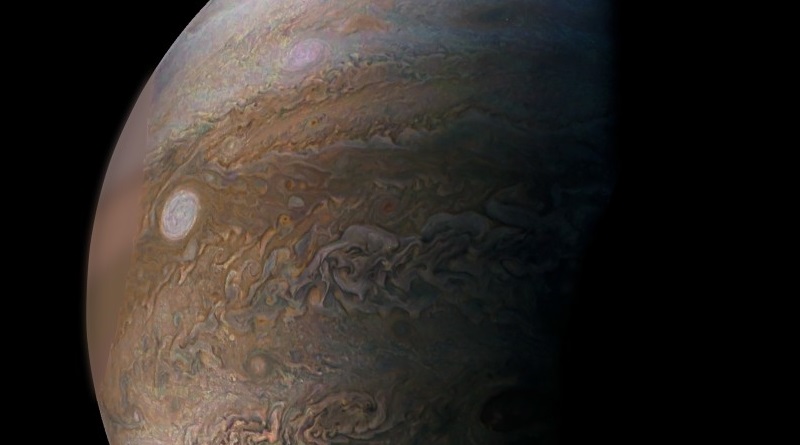Juno delivers new Data from Jupiter, Future Flight Plan under Evaluation
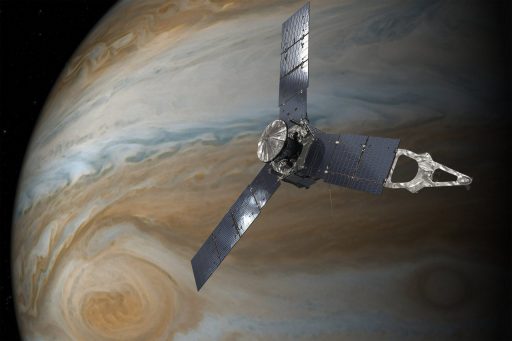
NASA’s Juno spacecraft brushed past Jupiter on Sunday, marking the mission’s first operational science data collection with seven of the craft’s instruments active as the probe zipped past the Gas Giant at a speed over 200,000 Kilometers per hour.
Sunday’s close pass, known as Perijove, represented Juno’s third encounter with Jupiter after entering a highly elongated orbit around the planet back on July 4 following a five-year odyssey through the solar system. The first close orbital pass on August 27 was dedicated to a checkout of the spacecraft’s instrument suite and, in addition to valuable science data, delivered the first photos of Jupiter from Juno’s unique vantage point in polar orbit.
The mission’s second low pass across Jupiter on October 19 was originally planned to be dedicated to what is known as the ‘Period Reduction Maneuver’ – the mission’s last major engine burn designed to lower the orbit’s high point and place Juno in a two-week orbit around Jupiter for more frequent close passes. This maneuver, however, had to be canceled due to a suspect signature from check valves within the spacecraft’s tank pressurization system which warranted additional study by engineers on Earth.
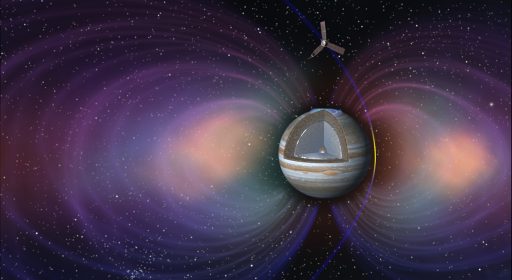
With the maneuver deferred, Juno’s second orbital pass was freed up for more science observations, but just hours before closest approach, the spacecraft entered safe mode when a flight software performance monitor sensed an unusual signature and commanded all but the most essential systems to shut down – including the science instruments which did not capture any data during the flyby.
Juno was recovered from Safe Mode within a week and was again outbound to a distance of over eight million Kilometers to Jupiter, set for another lap in its initial Capture Orbit with a small targeting maneuver to set up the precise location of the December 11 flyby.
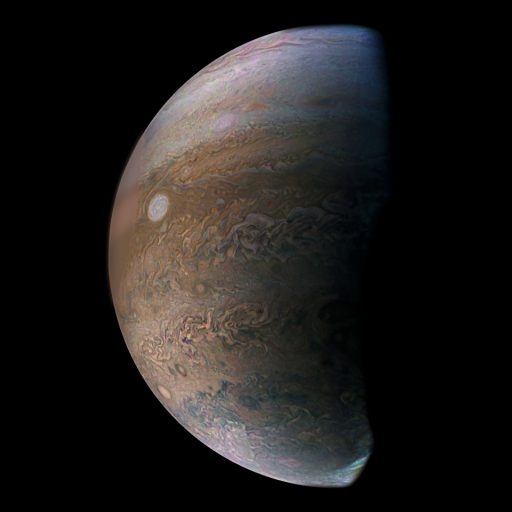
Closest approach took place at 17:04 UTC on Sunday with Juno flying 4,150 Kilometers above Jupiter’s enigmatic cloud tops at a speed of 57.8 Kilometers per second. This flyby was a ‘Gravity Science Pass’ which requires Juno to fly in a slightly different orientation to point the high-gain antenna toward Earth for highly sensitive dual-frequency ranging to reveal even the slightest change in velocity of the Juno spacecraft caused by gravitational features hidden beneath the dense cloud tops.
“This will be the first time we are planning to operate the full Juno capability to investigate Jupiter’s interior structure via its gravity field,” said Scott Bolton, Juno principal investigator. “We are looking forward to what Jupiter’s gravity may reveal about the gas giant’s past and its future.”
The only instrument that was sidelined for Sunday’s close encounter was JIRAM – the Jovian Infrared Auroral Mapper which has been taken out of commission to complete a software upgrade which will enable optimized instrument data processing.
According to NASA, the close flyby was successful and Juno collected a full complement of science data that was being downlinked to Earth at the start of the week. The agency also announced that concrete plans on a possible orbital adjustment are still being worked out as the mission team, in coordination with spacecraft engineers, evaluate the available options for modifying Juno’s orbit.
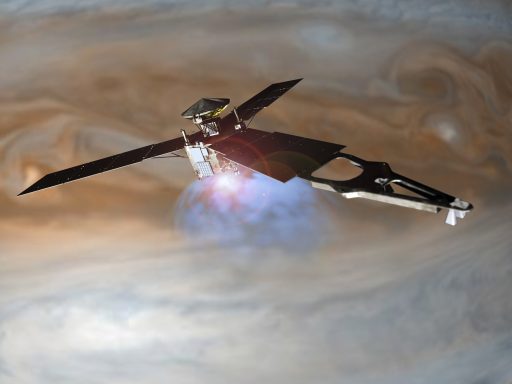
Three options exist for the future of the Juno mission: 1) keeping the spacecraft in its current orbit with science passes every 53.5 days, 2) firing the main engine for a full or partial period reduction to increase the frequency of science passes, 3) employing the monopropellant reaction control system to accomplish a partial period reduction to avoid the risk of firing the main engine, though at the expense of maneuvering propellant that could be useful in an extended mission.
Teams are in the process of assessing the risk associated with powering up Juno’s main propulsion system that so far performed three critical burns during the mission – a pair of Deep Space Maneuvers in 2012 and the Jupiter Orbit Insertion on July 4th. The Period Reduction Maneuver was to be the last use of the main engine.
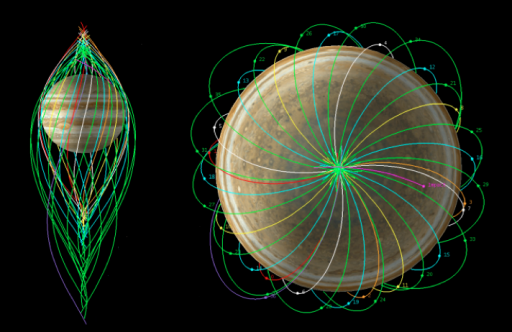
“We have a healthy spacecraft that is performing its mission admirably, and we are able to obtain great science every time we fly by,” said Rick Nybakken, Juno project. “What we do not want to do is add any unnecessary risk, so we are moving forward carefully.”
To satisfy its core mission objectives, Juno requires at least eight Perijove passes with active science collection in order to achieve a 45-degree spacing in longitude between the individual passes for a global assessment of Jupiter. The original mission design called for a total of 35+1 orbits to reduce the longitudinal spacing to 11.25 degrees for a comprehensive look at the hidden features below Jupiter’s cloud tops.
The geometry of the close passes of Jupiter is almost identical for the Capture and Science Orbits in terms of altitude and flight path with approximately three hours of science measurements on either side of the close approach.
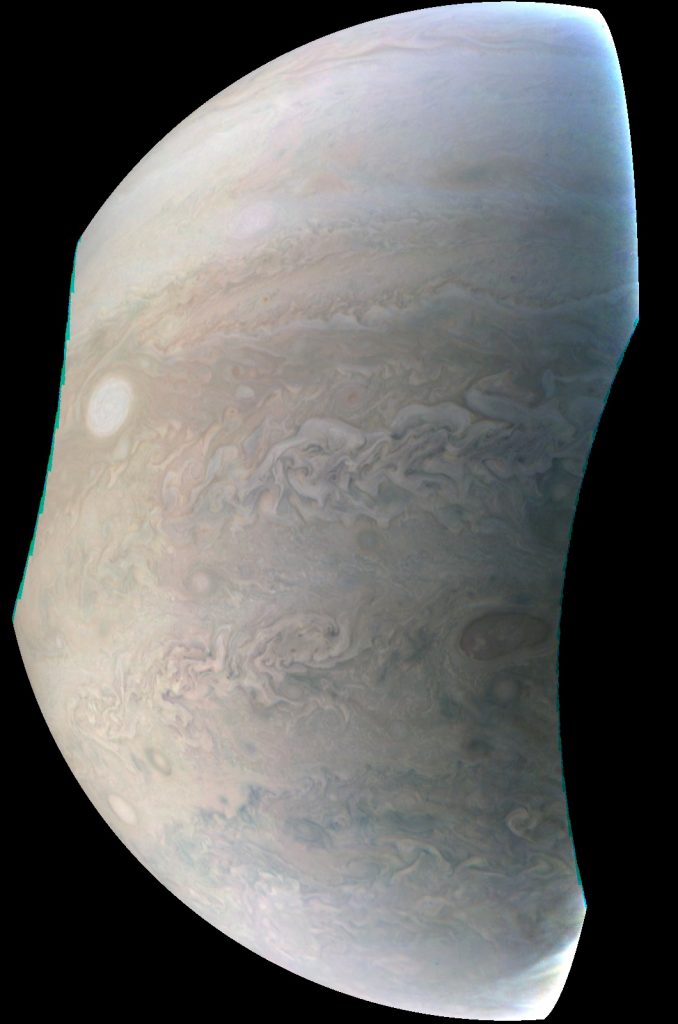
In the Capture Orbit, science passes are few and far between which, if a maneuver into the nominal science orbit is not possible, would mean Juno has to operate for a five-year mission to obtain the data that was to be collected in just 20 months per the original mission design. The biggest driver of Juno’s mission duration is the harsh radiation environment around Jupiter.
In addition to valuable science data from the majority of Juno’s instruments, Sunday’s close pass also delivered a new batch of photos captured by the JunoCam instrument and made available on the Internet to be processed and analyzed by the general public.
A featured image released by NASA on Wednesday shows a ‘Jupiter Pearl’ – a massive counterclockwise rotating storm that appears as a bright white oval in the gas giant’s southern hemisphere. Jupiter’s string of pearls is an ever-present phenomenon, though the number of storms has varied from six to nine since regular observations were started in 1986. Currently, Jupiter has eight peals – the photo shows the seventh.
The JunoCam image was taken at 17:27 UTC on Sunday, 23 minutes after closest approach when Juno was already 24,600 Kilometers from the planet.
Juno’s next close pass of Jupiter will occur on February 2, 2017.

